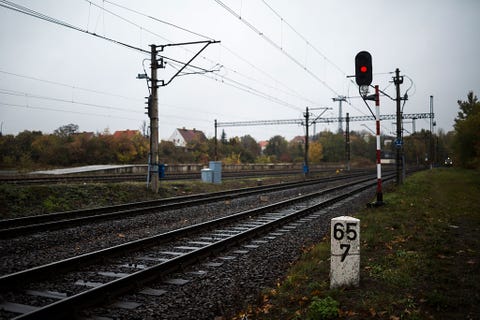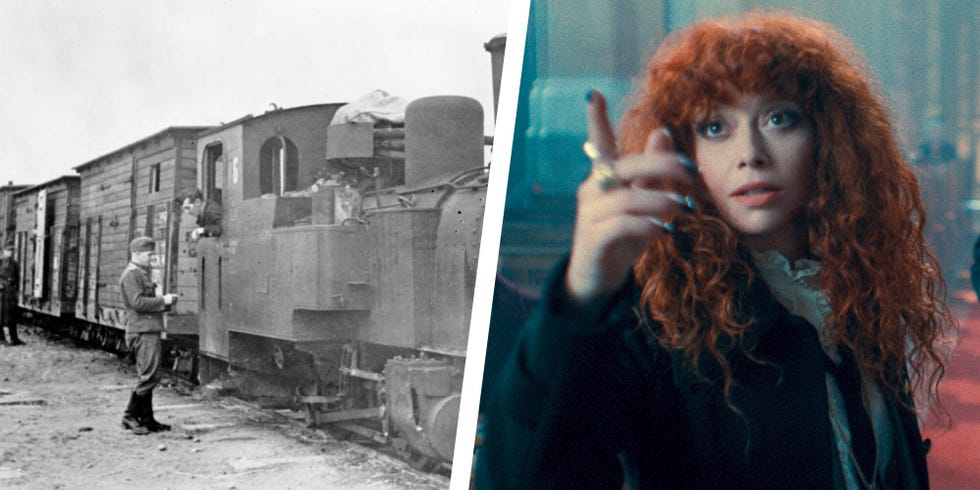
In season 2, Russian Doll exchanges its first season time loop premise for a series of subway wormholes, transporting Nadia (Natasha Lyonne) between 2022, 1982, 1962, and 1944—and confirming to all New Yorkers who ride the 6 train just how many barely-washed decades of hard plastic seat exist under their butts.
Trains are both the narrative vehicle of the season and its primary object: in particular, a Nazi gold train (called the “Hungarian Gold Train”) that allegedly contained valuable possessions “stored” for Hungarian and European Jews who were themselves hoarded onto different trains and transported to concentration camps. (Those latter trains are the locomotive images that haunt the second season without making an appearance—something perhaps too dark for the show’s more buyout tone.)
Nadia travels to Hungary, searching for clues about the Hungarian Gold Train. She had managed to find a receipt of sorts, which listed the exact box containing her family’s possessions. She learns that the train was likely looted by Nazi soldiers—though, it’s unclear if they stole her family’s box. She finds out later, however, that the train was first loaded in Budapest in 1944, before it was looted. At some point between the goods being loaded on the train and then later stolen from her mother (or lost by her mother), someone found the gold train, retrieved the family box, and exchanged its contents for gold coins.
This type of family saga isn’t entirely Tarantino in its Nazi fictitiousness. Stories of Nazi treasure—art, gold, trains, etc.—are common historical fodder, and are largely true; the Nazis did loot and hoard billions of dollars’ worth of gold. But there are just as many tall tales, conspiracies, and myths.
What about the Hungarian Gold Train?
Was the Hungarian Gold Train Real?

picture alliance
Yes.
In March 1944, Hitler invaded Hungary. In collaboration with Hungary’s fascist government, the German army began seizing property from the country’s Jewish population. The property—including gold and other valuables—was indeed placed in boxes and the owners given receipts. Their property, however, would never be returned, and many of Hungary’s Jews were instead transported to concentration camps. (Upwards of 600,000 Hungarian Jews are believed to have been killed during the Holocaust.)
When Allied and Red Army forces began closing in on Hungary in 1945, the Nazis packed the stolen goods (worth upwards of an estimated $120 million at the time—and over a billion today) onto 44 train cars and sent the train west.
But it wasn’t just the Nazi soldiers who looted the train on its way west. The U.S. Army seized the train later when it reached Austria. The train’s contents were then looted again and much of the art sold at auction.
According to a 2001 class action lawsuit, the U.S. military not only had receipts of the property contained on the train—meaning it would have been able to identify the original Hungarian owners and return the stolen goods—but the military also knowingly allowed top ranked soldiers to steal from the train.
In 2005, a $2.5 settlement was reached between the families and the U.S. government—though, the money was to be allocated to social service agencies serving Holocaust survivors.
Where much of the train’s contents ended up remains a mystery.
What about the Nazi Gold Train?

Gallo Images
Another Nazi train story involves a train that departed Poland around the same time as the Hungarian Gold Train. It’s referred to simply as the “Nazi Gold Train.”
The story goes something like this. In the final days of the war, beneath Allied airstrikes and with an advancing Red Army pushing west, a Nazi train full of gold departed from a station in southwest Poland but never reached its destination. The Germans had built a network of underground tunnels in the area, and it was believed the train had been redirected into these tunnels, stopped, abandoned, and then sealed off to evade discovery.
The Polish military at one time conducted a search for the train—as have many treasure hunters over the years—but so far, no one has found the train.
Unlike the Hungarian Gold Train, the “Nazi Gold Train” is believed to be mostly fictitious. Though, its victims are believed to be the same: European Jews whose property was taken by occupying Nazi forces.
This content is created and maintained by a third party, and imported onto this page to help users provide their email addresses. You may be able to find more information about this and similar content at piano.io
